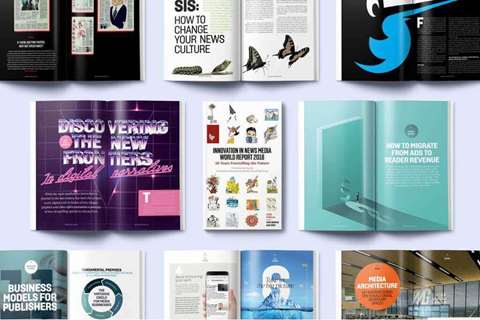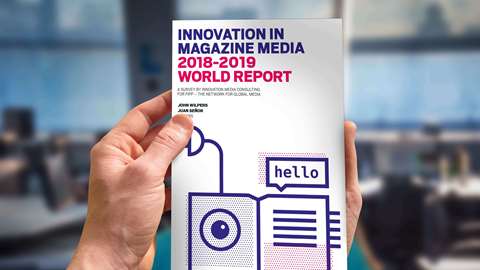The power of print at a glance:
- Consumers, particularly younger consumers, in the digital age are crying out for a print product that is unique, exclusive and targeted
- The smart print players will trial new revenue streams and embrace technology, provided it adds value for their audience
- Without a genuinely unique or in-demand content proposition, any attempt at ‘innovation’ will come to nought
Now in its 10th year, the annual FIPP Innovation in Media World Report catalogues the changes sweeping a convoluted and crowded media landscape. This year, it also doubles as a rallying cry for publishers, particularly print publishers, to cast off their shackles and “come out swinging”.
John Wilpers, author and co-editor of the 2019-20 edition, outlines potential revenue streams and technological applications media companies must adopt if they survive in the 21st century. “But all this talk of innovation and revenue diversification means nothing if they lack a genuinely unique or in-demand content proposition,” he says. “Otherwise, they’re putting lipstick on a pig.”
Publishers should be asking themselves: Do I have a unique content proposition and a willing audience? Does that content play to the medium’s strengths? Does it incorporate digital? And does it do so in a meaningful way?
There is a growing trend of publishers who are, according to the 2018 FIPP Innovation in Magazine Media World Report, obsessed with delivering a premium experience to smaller, select, lucrative audiences – becoming more exclusive and more targeted.
We’ve seen this with the successful (and glossy) rebrand of the Guardian Weekly mag, and with the expansion of the Monocle Summer Weekly to the colder months of the year. But we’ve also seen digital-only companies like Facebook and Airbnb experiment with print, both with magazines, while Amazon muscled in on the party with a children’s catalogue over the festive period.
“I think the outlook for print is a very positive one,” Wilpers says. “Because people, particularly younger people, are rediscovering that it’s a different kind of experience. Something worth paying for. When you pick up a magazine, it’s tactile, it’s a visual treat. I subscribe to the print issue of Sports Illustrated, and those images don’t affect me the same way online – particularly on my mobile phone.”
Wilpers recounts the story of a millennial-age survey respondent who, when asked why they bothered with print, replied that they sit in front of a screen at their desk and on the tube “all fucking day”. Why would they do the same in their downtime?
Digital natives they may be, but young ’uns are embracing print in greater numbers. Neil Howe, who helped to coin the term ‘Millennial Generation’, writes that 92% of college students “prefer reading print material to digital material”, and find it to be both more trustworthy and engaging.
Millennial-age readers are opting in to the print edition of The New Yorker at a rate 10% higher than older demographics, while new subscribers to The Atlantic in the 18- to 24-year-old age bracket jumped 130% in the year to November 2017.
However, warns Wilpers, “media companies can’t have only one arrow in your quiver and expect to survive.” And though we’ve seen the pendulum swing away from the ‘print is dead’ mantra, there’s very little – if any – commercial opportunity for standalone print titles.
The concern for Wilpers is that too few legacy companies are taking the necessary steps to survive, failing to test new revenue streams and adapt to print’s place in the marketing mix. There’s also the fear that media companies are using tech not because it adds value to the reader or advertiser, but simply because they can.
We’re seeing many fall foul of what the Reuters Institute for the Study of Journalism calls the “Shiny Things Syndrome”. Writing in a report titled Time to step away from the ‘bright, shiny things’?, author Julie Posetti says there is evidence that change fatigue and burnout risks stifling journalism innovation efforts.
“To be clear, some media companies are turning formerly shiny new things into real, useful, successful media tech, such as voice-enabled devices, artificial intelligence (especially for robotic content creation) and messaging apps, among others,” says Wilpers. But the likes of virtual reality and blockchain are at best distractions, and at worse both time and resource drains for a companies facing serious revenue and resource challenges.
“Print will never go away. It will always be a strong member of the media family,” says Wilpers. “But the real success comes from understanding your audience and giving them what they’re looking for with a unique and enriching platform.”
Older names, like National Geographic and The New York Times are using the goodwill and loyalty generated by print as a jumping off point for fresh experiences.
The former became the first brand to top 100 million followers on Instagram, while the latter made the autumn 2018 Voyages edition of its New York Times magazine a soundscape ecology project. By firing up the associated podcast, readers could listen to a national park in Mozambique, rats in New York subways, even the sound of lava flowing from Kilauea – all while reading the magazine.
Others, like Cosmopolitan, are hooking up with digital partners to bring something new to the print experience.
In the October 2018 issue of the magazine, Cosmo featured a first-of-its-kind “virtual try-on” in partnership with Macy’s. Using an eight-page native content package, readers were invited to snap a special QR code and visit Cosmopolitan.com, where YouCam Makeup facial mapping technology allowed them to see how the make-up they chose would look on them. If they liked the look, they could purchase the make-up by clicking straight through to the Macy’s online store.
For those of you thinking this sounds like nothing more than a novelty, as many as 73% of readers took up the publisher on the app-urtunity. Sorry.
Wilpers points to these and other examples as reminders for publishers to re-examine and embrace what it is they do well. To ask whether they have the talent in-house to create content. To create products, events and services clients are willing to pay for. Because, he continues, media companies have been on the defensive for too long.
So ditch the bus, get out of the curl, and come out swinging and smiling.





